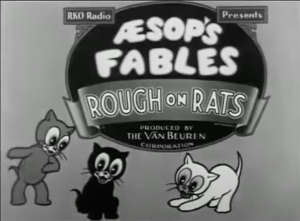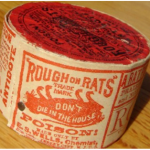
August 14, 2024, by Arts Placements
Exploring Poison, Crime and Cartoon Cats? Lessons from My Research Placement
By William Cox
Introduction
Throughout the last two years of my time at the University of Nottingham, I have been presented with many opportunities to build and refine my research skills, explore unique historical topics, and engage deeply with primary sources. I successfully applied for the Summer Research Placement Programme, I knew that this placement would allow me to be at the front and centre of new research, and potentially change the way we think and approach historical topics. However, I never foresaw how my research would lead me down unexpected paths, including uncovering surprising connections between crime, popular culture, and even cartoon cats.
Uncovering the Infamy of a Household Poison
During my time researching on the project titled ‘Investigating “Rough on Rats” and Criminal Uses of Rat Poisons in the U.S., c. 1880-1920’, alongside Professor Vivien Miller. I was tasked with compiling a bibliography of primary and secondary sources related to the pesticide “Rough on Rats”. This was a seemingly straightforward task about an innocuous product was developed by entrepreneur Ephraim S. Wells in 1872. As the name suggests, it was a rat poison. Its alliterative name and over-the-counter availability made it a household necessity.
However, little did I know that this small, everyday product would have such a dark and ‘rough’ history. By using the Gale Primary Sources online database that the University is subscribed to, I delved into over 4,000 American newspaper articles featuring the phrase “Rough on Rats”. What I discovered was a series of chilling stories — homicides, suicides, and accidental poisonings — that reflected the product’s infamous legacy. Each article offered a piece of a larger puzzle, and this process developed my ability to analyse and synthesise vast amounts of information.
As someone who holds ambitions of becoming an academic researcher in the years to come, this placement sharpened my attention to detail. It also demonstrated the importance of teasing out the nuances of every source that you might come across when researching. It became clear to me that “Rough on Rats” was more than just a poison. It was a symbol of something more sinister. Its widespread use in various crimes made it a recognisable name for all of the wrong reasons. By the early 1900s, the phrase “Rough on Rats” had evolved from a simple brand name into an idiom that reflected a something harsh or dangerous. My research had discovered a transformation in language, underscoring the deep cultural impact of the product.
When Crime Meets Cartoons
Just when I thought I had a firm lead on the historical implications of “Rough on Rats”, my research took an unexpected turn — into the world of cartoon cats. Yes, you read that right. As I explored the broader cultural impact of the phrase, I stumbled upon references in popular media, including cartoons and advertisements. Despite the fact that some of these sources contained no explicit mention of the product, other than sharing the name, I understood these to be nods to the cultural pervasiveness of “Rough on Rats”. Whether this be the prevalence of cats in the marketing material for the “Rough on Rats” product, or the short animated film Rough on Rats, released in 1933, this served as a reminder of how the product had embedded itself into the fabric of everyday life.
This phase of my research taught me the importance of being open to unexpected findings and thinking creatively about how different cultural elements intersect. I also used this as an opportunity to contextualise sources within broader cultural trends. It was a fascinating and somewhat surreal experience to see how a product with such a dark history could be reinterpreted in a light-hearted, even humorous context. This placement showed me how cultural symbols can be repurposed across different media.

From Clues to Conclusions
Reflecting on my placement experience, I can see how it has significantly shaped my skills as a researcher. I learned how to work effectively with primary sources, managing large datasets while maintaining a focus on the broader research question. The process of investigating “Rough on Rats” underscored the value of adaptability and curiosity in research — qualities that I will carry with me into future projects.
Moreover, this placement has influenced my future aspirations by deepening my interest in the intersection of History and culture. It has shown me the importance of approaching research with an open mind, ready to follow the evidence wherever it may lead — even if it means encountering a few cartoon cats along the way. The skills I developed during this placement, from critical analysis to creative problem-solving, have not only enhanced my academic abilities but also prepared me for a future career in research.
My research placement at the University of Nottingham has been an eye-opening journey I encourage fellow students to embrace similar opportunities and to approach their research with curiosity and an open mind – you never know where it might take you!
No comments yet, fill out a comment to be the first


Leave a Reply